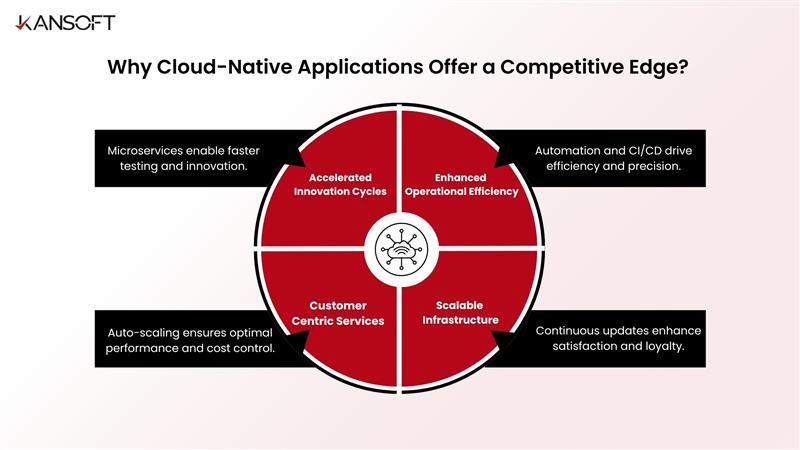In today’s fast-paced digital economy, businesses are judged not just by the quality of their products or services, but by how quickly they can adapt to market changes. Customers expect seamless, reliable, and constantly evolving experiences. For enterprises aiming to stay ahead, Cloud-Native Application Development has emerged as a game-changing strategy. At Kansoft, we specialize in cloud-native application development, helping enterprises accelerate innovation while optimizing costs.
By designing applications specifically for cloud environments, organizations can accelerate innovation, scale efficiently, and ensure technology investments remain future-proof. However, for executives, adopting a cloud-native approach presents a critical challenge: balancing agility with cost efficiency and operational control.
Understanding Cloud-Native Application Development
At its core, cloud native software development is a methodology for building and running applications that take full advantage of cloud computing capabilities. Unlike traditional software, cloud-native apps are designed to be:
- Scalable: They can automatically adjust to fluctuations in demand without manual intervention.
- Resilient: Failures in one component don’t crash the entire system.
- Agile: Developers can deploy updates and new features quickly and frequently.
- Flexible: They can integrate emerging technologies like AI, machine learning, and analytics effortlessly.
For executives, it’s important to see cloud native app development not just as a technical improvement, but as a strategic lever that directly supports business goals. It enables faster delivery of value, better customer experiences, and a platform for sustainable innovation.
The Role of Hybrid Cloud Deployment Model
Many enterprises are moving beyond single-cloud strategies to embrace a hybrid cloud deployment model, which combines private and public cloud environments. This approach offers significant advantages:
- Optimized Resource Allocation: Sensitive data can reside on private clouds while high-demand applications leverage the public cloud.
- Risk Mitigation: Workloads are distributed, minimizing downtime risk and ensuring business continuity.
- Cost Efficiency: Organizations can balance performance with cost, avoiding over-provisioning while optimizing cloud infrastructure.
The hybrid model is particularly effective for large enterprises handling complex workloads. For instance, a financial services company might store client data in a private cloud to comply with regulations, while deploying analytics applications on a public cloud for scalability. Kansoft’s expertise in designing hybrid cloud deployment models ensures your applications are secure, scalable, and cost-efficient.
According to Microsoft Azure, hybrid cloud strategies help enterprises maximize performance while maintaining security and compliance standards, a key consideration for businesses adopting cloud-native solutions.
Why Cloud-Native Applications Offer a Competitive Edge

The competitive advantage of cloud-native application development goes beyond cost savings. Here’s how executives can measure its impact:
- Accelerated Innovation Cycles: Microservices and containerized applications allow teams to develop, test, and deploy features independently. This reduces time-to-market and enables rapid experimentation.
- Enhanced Operational Efficiency: Automation, continuous integration, and continuous delivery pipelines reduce manual interventions and human errors.
- Scalable Infrastructure: Applications can automatically scale up during peak periods and scale down during low-demand periods, ensuring resources are used efficiently.
- Customer-Centric Services: Faster updates, high availability, and personalized experiences improve customer satisfaction and loyalty.
By focusing on outcomes rather than just technology, executives can connect cloud-native investments to tangible business results.
Implementing Cloud Infrastructure Optimization
Cloud Infrastructure Optimization is critical for maximizing the ROI of cloud-native initiatives. Without it, organizations risk overspending on unused or misconfigured resources. Key steps include:
- Monitoring and Analytics: Track utilization patterns, performance metrics, and spending trends to identify inefficiencies.
- Automated Scaling and Rightsizing: Adjust compute and storage resources automatically based on workload requirements.
- Cost-Aware Development: Encourage teams to build applications with cost efficiency in mind, such as using serverless architectures or optimizing data transfers.
- Regular Audits: Periodically review deployments, identify redundant resources, and implement corrective actions.
Through these practices, executives can ensure that cloud-native strategies are cost-effective and aligned with organizational objectives.
Best Practices for Executives in Cloud-Native App Development
Adopting cloud native software development requires a strategic approach, not just a technical upgrade. Executives should focus on the following best practices:
- Align Technology with Business Goals: Every cloud-native initiative should have clear business objectives, whether improving time-to-market, enhancing customer experience, or reducing operational costs.
- Prioritize Microservices and Modular Architecture: Modular applications allow for independent scaling and faster updates without affecting the entire system.
- Foster a DevOps Culture: Continuous integration and delivery pipelines empower development teams to innovate while maintaining quality and stability.
- Embed Security and Compliance: Security considerations must be integrated into the development lifecycle, especially for hybrid or multi-cloud environments.
- Measure Outcomes, Not Just Metrics: Beyond uptime and server utilization, track business KPIs such as customer engagement, revenue impact, and adoption rates.
By implementing these practices, executives can ensure cloud-native adoption delivers strategic value.
Real-World Examples of Cloud-Native Success
Consider a retail company preparing for a major holiday sale. Traditionally, scaling their infrastructure to handle high traffic would take weeks, involving significant capital investment.
With cloud-native application development and a hybrid cloud deployment model:
- Web and payment systems automatically scale to meet demand.
- Updates and bug fixes can be deployed in real-time without downtime.
- Data analytics can guide marketing strategies dynamically, improving conversion rates.
Similarly, enterprises in healthcare, finance, and logistics leverage cloud-native apps to innovate faster, optimize infrastructure costs, and respond dynamically to changing market demands.
Gartner reports that enterprises adopting cloud-native architectures experience faster innovation cycles, improved operational resilience, and lower costs compared to traditional monolithic systems. Gartner Report on Cloud-Native Applications.
Maximizing ROI Through Cloud-Native Strategies
One of the biggest concerns for executives is whether cloud-native investments justify their cost. By combining cloud native app development with cloud infrastructure optimization, organizations can:
- Reduce Operational Costs: Automation and optimized resource allocation minimize unnecessary spend.
- Accelerate Revenue Generation: Faster deployment cycles translate into quicker product releases and revenue opportunities.
- Enable Safe Experimentation: Teams can innovate without impacting existing services, creating long-term value.
- Enhance Customer Experience: Highly available, scalable, and responsive applications improve satisfaction and retention.
Framing cloud-native initiatives in terms of strategic business value rather than just infrastructure cost is the key to unlocking measurable ROI.
Preparing Your Organization for the Future
The digital landscape is evolving rapidly, and enterprises must adapt or risk falling behind. Executives can future-proof their organizations by:
- Treating cloud-native application development as a core capability rather than a one-off project.
- Leveraging hybrid cloud deployment models to optimize performance, compliance, and cost.
- Embedding cloud infrastructure optimization into operational workflows.
- Encouraging continuous learning and adoption of new cloud-native tools and technologies.
Organizations that master these principles gain a significant competitive edge, transforming cloud investments from a cost burden into a growth engine.
Conclusion
Cloud-native application development is more than just a technology shift, it’s a business transformation. For executives, it provides a framework to balance agility, innovation, and cost efficiency.
By adopting best practices, leveraging hybrid cloud environments, and continuously optimizing infrastructure, enterprises can:
- Accelerate innovation cycles
- Reduce operational costs
- Deliver exceptional customer experiences
- Maximize ROI
Cloud-native strategies are no longer optional they are a necessity for digital-first businesses that want to stay competitive in a rapidly evolving market.



